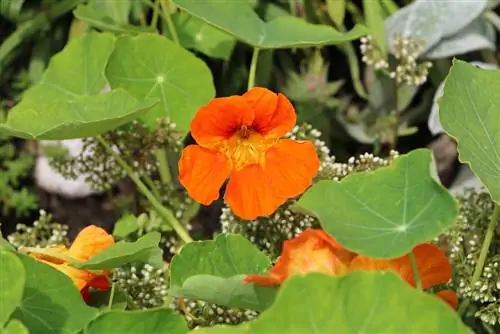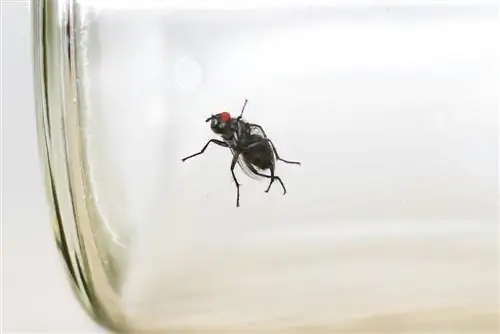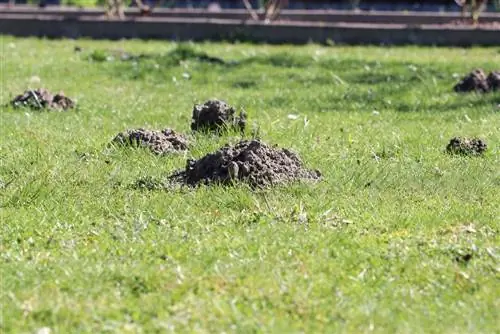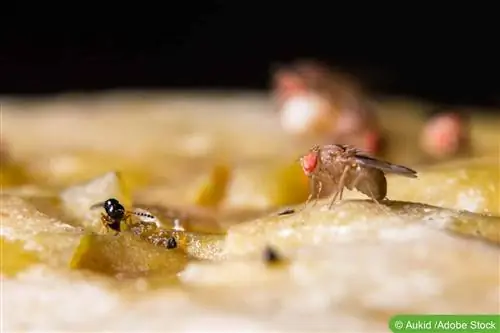- Author admin [email protected].
- Public 2023-12-17 03:39.
- Last modified 2025-01-24 12:45.
Flies are annoying and can transmit a variety of diseases when they visit. Even the cold season does not protect against potential pathogens. A few warm rays of sunshine are enough to wake the insects from their cold torpor. The winged pests are often around the house all year round. The use of chemical products can provide short-term relief, but is not always recommended and can cause lasting damage to the environment. With the right herbs and plants you can keep flies away.
Remedy with herbal help
The little troublemakers can become a nuisance in the summer, not just in rural areas with a farm in the immediate vicinity. A warm climate favors the reproduction of insects and within a few weeks the flies can develop into an unpredictable nuisance. In the wild, the animals are an indispensable part of the local flora and fauna, but in your own kitchen they represent a serious problem.
Over the course of their short lifespan, which is usually only a few weeks or days, flies can transmit over two million pathogenic germs. An almost immense number when you consider the small size of the animals. In exceptional cases, diseases such as typhus, salmonella and polio are said to have been transmitted by house flies. The animals feed on dead plant and animal remains. Depending on the type of insect, a rotting apple is just as disdained as the recently deceased shrew in the ornamental bed. In addition to the high risk of infection, flies are anything but clean creatures. The black spots on the window panes and the room walls make this clear.
Insects fly on smells and this fact can be used effectively. Whether in the garden or on the windowsill, with the right selection of plants it is possible to keep the pests at bay. It doesn't matter whether you have your own garden or have greenery on your windowsill at home. When choosing plants, it is important to make sure you choose the right varieties. The intense smell of many plants drives away flies. Other herbs and flowers, however, have specialized in attracting insects.
Nasturtium
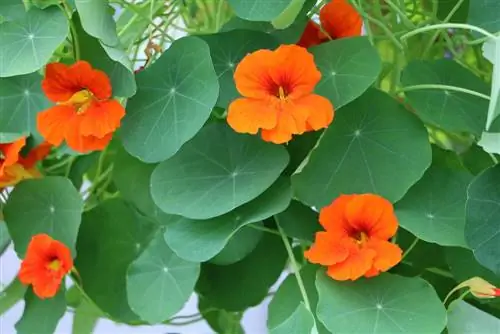
Bright flowers and circular leaves are the characteristic trademark of nasturtium. The plant is an all-round talent in the garden and not just because of its high vitamin C content. Tropaeolum majus has been valued as a medicinal herb for centuries; in the kitchen it enhances soups and salads with its pungent leaves and decorative flowers. The perennial delights with its striking flowers well into November, the smell of which effectively repels flies. Nasturtium has the following benefits:
- Robust
- Easy care
- Shade tolerant
- Growing fast
- Insensitive to snails
The location plays a minor role for the plant, which comes from South America. To give the fleshy tendrils a stable hold, trellises or garden fences are helpful. With nasturtiums you can create a dense, decorative privacy screen around the terrace that keeps flying pests away and at the same time enhances your food. The downside: The useful plant is an annual and has to be sown in the garden every year.
Catnip
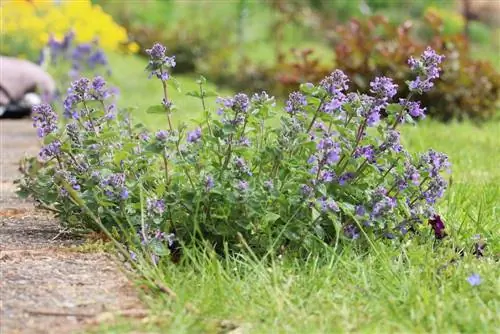
Nepeta cataria is no stranger to cat owners. The plant, known as catnip or cat balm, is a member of the mint family and has a calming effect on nervous cats. The intoxicating and beguiling effect of the plant has a particular effect on tomcats, who happily roll around in the plants and nibble on them. A few years ago, American researchers demonstrated that catnip is many times more effective against flies than the anti-mosquito agent DEET, which is used in many anti-mosquito products. The essential ingredients of the plants are also said to have been effective against yellow fever mosquitoes.
- Catnip is not poisonous
- Can reach a height of up to 100 cm
- Perennial with upright stem
- Robust and resilient
The smell of real catnip is lemon-like and reminiscent of mint. Visitors to the strikingly smelling flowers include beneficial insects such as bumblebees and bees. For them, Nepeta cataria is a rich source of nectar that they prefer to fly to. At the same time, the plant's intense scent drives away flying pests such as houseflies etc. Cat balm is hardy and can be overwintered in the garden without much effort.
Due to their height, you can plant the perennials in the back edge of decorative beds or use them to border paths. Preferably in places where you regularly have to deal with a plague of flies in summer. However, be aware that you won't have the plant to yourself. The trivial name of the mint family is by no means a coincidence. Because many cats are magically attracted to the perennial. The four-legged friends not only roll around in the plants, but also eat them.
The advantage of catnip: The perennial is content with small planters and thrives splendidly on the balcony and terrace. Placed on the outer window sill you can prevent flies and mosquitoes from getting into your living space.
Tip:
Plant Nepeta between roses and protect the “Queen of Flowers” from aphids and other pests.
The Mediterranean Oasis
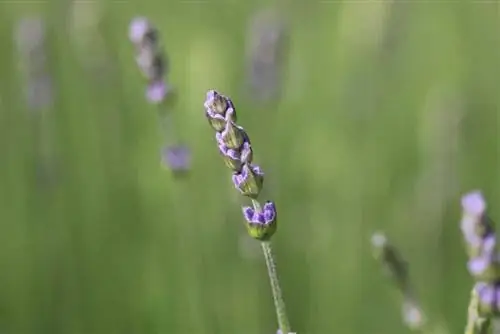
Plants from the Mediterranean region are an enrichment for the garden and terrace. The plants conjure up an exotic atmosphere through their color and appearance. Passionate lovers of Mediterranean plant beauty go one step further and decorate their garden completely in the style of the Mediterranean. Many of the plants have a high content of essential oils, which keeps flies and other annoying insects at bay. The classic pest repellent is undoubtedly lavender. The plant with the purple-blue flowers and herbaceous growth can reach a height of up to 150 cm. The intense smell of the mint family when fresh and dried keeps flies, mosquitoes and moths away. Scented sachets filled with dried lavender have been used successfully to protect textiles for decades.
- Lavender is a subshrub
- Needs a sunny and wind-protected location
- hardy
- Tolerates lean substrate
Due to its low maintenance requirements, the mint family is a plant that you can leave to your own devices. Lavender looks just as good in the rock garden as it does in the flower pot on the windowsill. Plants in the bucket can be moved as desired. Flies prefer a warm, sunny location. The same conditions that Lavandula angustifolia needs to grow. Plant the ornamental plants where the flying pests are particularly hard on you. You can use dried lavender shoots to protect your textiles and food from moths.
Tip:
Aphids and slugs also avoid Mediterranean plants.
Peppermint in the garden
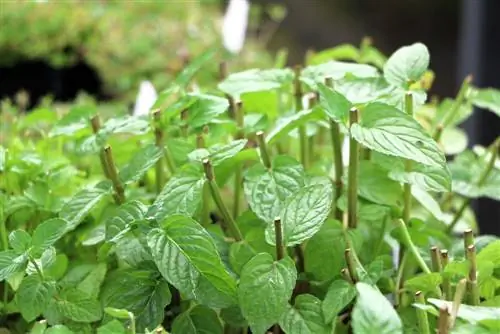
Some types of mint, especially peppermint, act as reliable protection against flies. The genus Mentha is also no stranger to home gardens and has long been used as a medicinal and useful herb. The aromatic taste of peppermint tea is known to almost all of us, and the leaves of the plant also make a tasty addition to salads and meat dishes. The strong smell of the plants only becomes apparent when the leaves and shoots are injured. To keep insects away in summer, it is advisable to rub a few leaves of the robust plant between your fingers every now and then.
- Peppermint needs a sunny location
- The plant reproduces quickly through underground root runners
- Only suitable as a container plant to a limited extent
- Dried shoots on the windowsill keep flies away
Mints thrive in dry areas of the garden. You can combine the plants with roses and other ornamentals that share similar conditions in terms of location and substrate.
Tasty culinary herbs
With fresh herbs from your garden you can enhance your dishes and repel flies. Basil is one of the pioneers in this field. For Italian gourmets, this fresh herb is a must in every dish. Cultivate the plant on the windowsill and keep your kitchens insect-free.
- The mint family is a light germinator
- Temperatures around 20° C are necessary for germination
- Cannot tolerate drought or waterlogging
- The location should be sunny and warm
- Protect from drafts
Chives
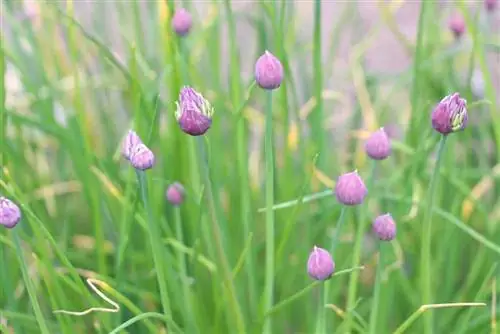
Allium schoenoprasum originally occurs in cooler areas and has different keeping conditions than basil. Flies and mosquitoes react sensitively to the strong, spicy smell of the plant and avoid the plant. Always cut only the required amount of chives. The herb is fast-growing and regenerates quickly from this measure.
- Chives are perennial herbaceous plants
- Can reach a height between 10 and 50 cm
- Train daughter bulb
- Water and fertilize regularly
- Remove excess water in the planter
Edible plants to repel flies
Tomatoes are a tasty and versatile vegetable. The large, Mediterranean plants decorate many kitchen and ornamental gardens in summer. Only a little effort is necessary to grow the plants yourself from seeds and to achieve a successful tomato harvest. The leaves and shoots of the plant emit an intense smell. Planted close to the house, you can use tomatoes to ward off flying pests. However, the measure only works in the area around the delicious plants. A minimum distance must be maintained when planting. This allows the individual specimens to develop optimally and makes it more difficult for diseases to spread. Take advantage of this fact and frame part of your terrace with tomato plants.
- Tomatoes are perennial plants
- The plants react sensitively to cold and frost
- Tie up the shoots with the heavy fruits
- Avoid waterlogging when watering
- Wet leaves promote tomato blight infestation
Pole and bush beans have an intense scent that keeps flies and other flying pests at bay. The plants with the vitamin-rich legumes come from the family of butterflies and need a climbing aid.
- Depending on the variety, the plants grow bushy
- Annual plants
- Need a sunny location
- Not suitable for planting in containers
- When raw, all parts of the plant are inedible
Due to their height and shape, beans are not suitable for every area of the garden. If you are not a fan of the versatile legumes, take advantage of the opportunity to individually incorporate the climbing plants into your green garden landscape. For example, you can decoratively cover up the dreary garden fence with pole beans.
Useful plants for the balcony
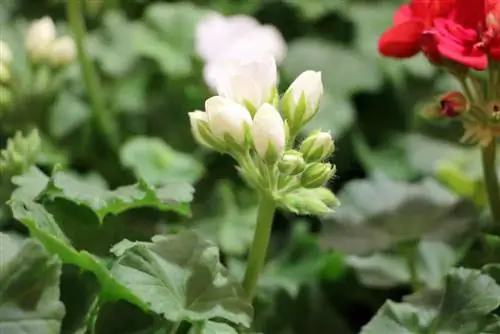
Herbs and vegetable plants are versatile and are used in the kitchen as well as to ward off flies. But these plants are rarely an adornment for the balcony or terrace. Lavender and basil work against the flying pests, but when planted solitary over a larger area they create a monotonous picture.
Geraniums and marigolds are distinctive plants that impress with their colorful flowers and keep insects away with their smell. Geraniums transform the location into a colorful oasis of well-being. Only a little effort is necessary to encourage the plants to bloom for a long time.
- Geraniums need a frost-proof room to overwinter
- A sunny to partially shaded spot is ideal
- The ornamental plants need 4 to 6 liters of water per week
- Remove wilted inflorescences regularly
Marigolds are a lush ornament in the bed and can be maintained on the balcony railing without much effort. Calendula officinalis, the Latin name of the traditional medicinal plant, needs a location in full sun and its fragrant flowers keep flies away from June onwards. The plant is also an important source of nectar for bees and butterflies. Marigolds are suitable as cut flowers. Use this opportunity to keep house flies etc. away from the dining table.
Conclusion
Like many insects, flies are sensitive to smells. With the right plants, you can take advantage of this fact and block access to living spaces with intensely smelling plants. A variety of annual and perennial plants can be used in many different ways and are used in the kitchen as spices, tea or salads. Even if a large number of pests are impressed by the smell of lavender and the like, the plants do not offer absolute protection against flies. A few stubborn representatives of the insects are not impressed by the scent. That's why it's advisable not to rely on plants alone, but to combine several methods of fly repellent.

